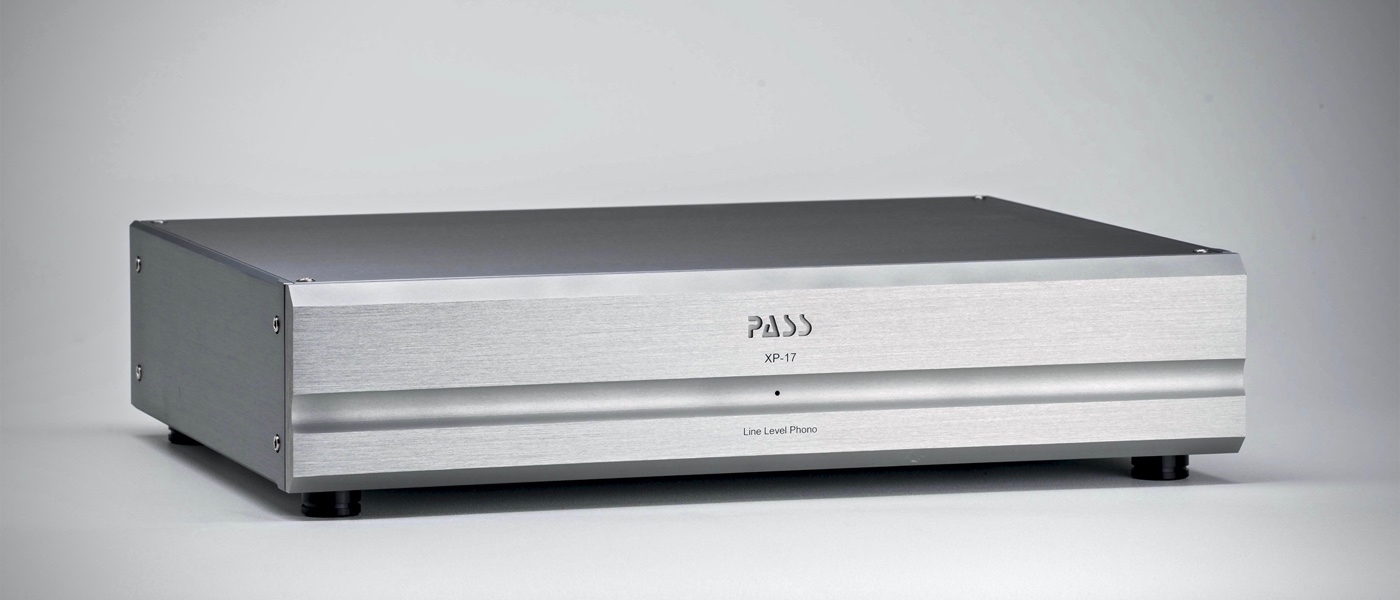Besides being incredibly simple to set up, the McIntosh D1100 proved capable of reproducing digital files of all types with incredible clarity and realism.
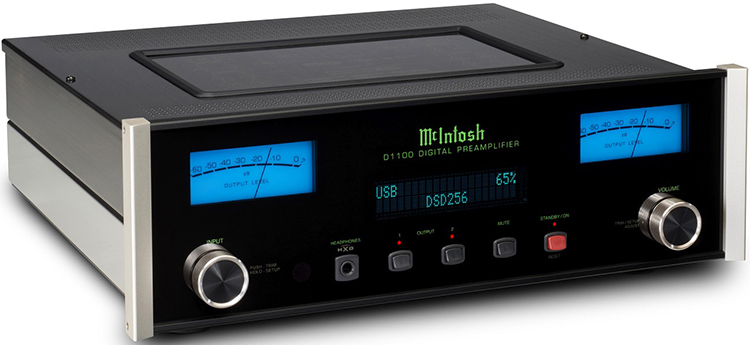
McIntosh D1100 2-Channel Digital Preamplifier
- Iconic McIntosh aesthetics and design
- Tons of digital inputs
- Seamless connectivity to other McIntosh devices (via MCT and digital triggers)
- Supports multiple stereo zones
- Highly revealing of source material
- DAC can handle almost any currently available digital format (PCM, DSD, DXD) at very high resolutions
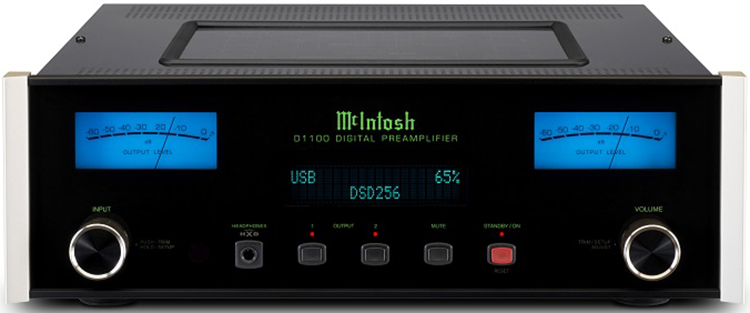
McIntosh is one of the few brands instantly recognized by any audiophile. Generally excellent performance, a consistent design aesthetic, and their trademark glowing blue analog meters have made McIntosh products a staple of the audiophile marketplace for nearly 70 years. I’ve had the opportunity to listen to many McIntosh products and have always been impressed with their design and sound quality. Sadly though, I had never had the chance to hear one in my own home – until now.
Preamplifier Section:
Total Harmonic Distortion: 0.0015% (at 2V Output)
Frequency Response:
+/-0.5dB from 4Hz to 20,000Hz, +0.5/-3dB from 4Hz to 68,000Hz
Maximum Volts Out:
16V RMS Balanced, 8V RMS Unbalanced
Signal to Noise Ratio:
111dB (A-weighted)
Dynamic Range:
100dB
Output Impedance:
100 ohms Balanced and Unbalanced
Headphone Load Impedance:
20 – 600 ohms
Tone Controls:
None
Inputs:
3 x Digital Coaxial (2 RCA, 1 BNC), 3 x Digital Optical, 1 x Digital MCT (DIN), 1 x Digital AES/EBU, 1 x USB Type B, 1 x RS232 control, 1 x Rear IR
Outputs:
3 x stereo XLR balanced (1 fixed, 2 variable), 3 x RCA unbalanced (1 fixed, 2 variable), 1 x ¼” headphone, 4 x control triggers, 4 x data ports
DAC Section:
Formats Supported via Digital Inputs (Coaxial, Optical, BNC, and AES/EBU): 44.1kHz-192kHz/24-bit
Formats Supported via MCT input: 44.1kHz/16-bit, DSD64
Formats Supported via USB Input: 44.1kHz-384kHz/32-bit, DSD64, DSD128, DSD256, DXD352.8kHz, DXD384kHz
General:
Dimensions (H x W x D): 6” x 17.5” x 19”
Weight:
26lbs
Warranty:
3 years parts and labor
MSRP:
$7,000
Company:
SECRETS Tags:
McIntosh Labs, D1100 2-Channel Digital Preamplifier, Preamplifier, 2-channel, stereo preamp, Preamplifier Reviews 2017
While I have typically been more a home theater/multi-channel audio kind of guy, I have been slowly delving into the realm of high-resolution stereo. Spanning from my appreciation for the sound quality offered by high resolution disc formats like SACD and DVD-Audio, file-based high-resolution music is a natural progression for me. As such, when the opportunity to review McIntosh’s latest preamplifier/DAC combo presented itself, I jumped at the chance.
The D1100 2-Channel Digital Preamplifier is something of a split from the traditional for McIntosh. Eschewing any analog inputs, the back panel contains nothing but digital connections. While there has been a recent resurgence in vinyl playback, it seems that many audiophiles are gravitating towards file-based playback and the D1100 is targeted squarely at those customers. McIntosh took things one step further by imbedding a high-quality DAC right inside. As someone who listens to nothing but digital files, I figured I’d be a good test for the D1100. Can the McIntosh D1100 2-Channel Digital Preamplifier be the centerpiece of your digital music system? Let’s hook it up and find out.
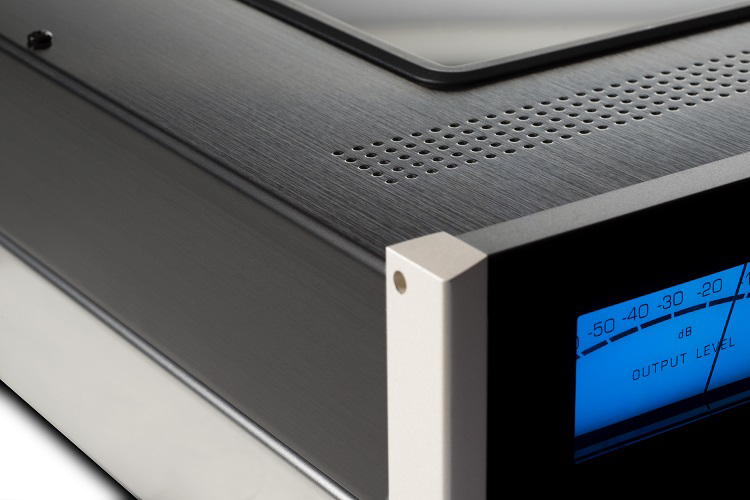
If you’ve been following the high-end audio scene at any point in the last 50 years or so, you know exactly what a McIntosh product looks like. The chassis is constructed of stainless steel in a mix of hairline-brushed “Black Titanium” and polished steel finishes. The front panel is black glass with brushed aluminum end caps.
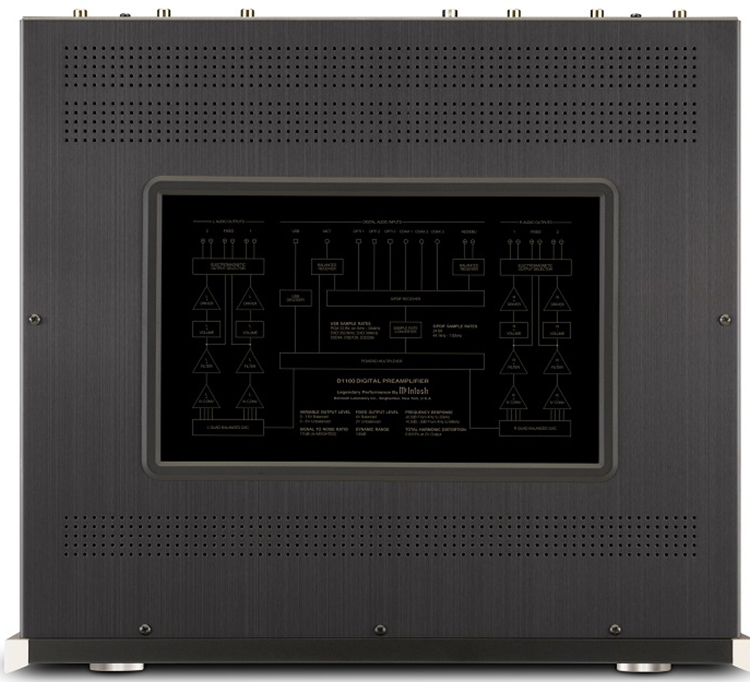
The top of the chassis sports a neat schematic of the components and signal paths that each input & output follows along with the file types supported by each input. Not only useful, it is also a very creative design touch. A generously-sized display screen is centered on the front panel and is flanked by the trademark McIntosh blue output meters, which glow when the unit is powered on. You can disable the meter lighting if you desire. There is a knob to select the input source and a second knob to control the volume. There is also a ¼” headphone jack and dedicated buttons for Outputs 1 and 2, Standby, and Mute. Overall, it is a very clean and classy look and will match beautifully with any other McIntosh components in your equipment rack. The design is clean enough to blend well with non-McIntosh gear as well.
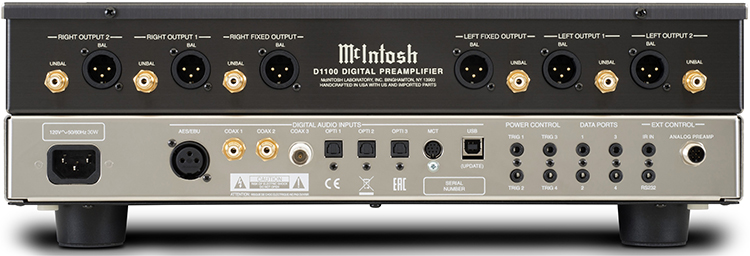
The back panel sports a whopping nine digital inputs: three Coaxial Digital, three Optical Digital, one MCT (a proprietary McIntosh format), one AES/EBU, and one USB Type B to connect to a computer. The USB jack can also be used to update the firmware if needed. On the output side of things are two pairs of fixed-level analog outputs (one Balanced XLR and one Unbalanced RCA), plus two additional sets of variable analog outputs (one Balanced XLR, one Unbalanced RCA) for both Output 1 and Output 2. With the buttons on the front panel and the remote to enable/disable these outputs, you could easily use the D1100 to control a multi-zone audio system. Rounding out the back panel are IR and RS232 inputs, four trigger outputs, four data ports (digital control outputs used with other McIntosh components), and a special connection to mate the D1100 with McIntosh’s C1100 analog preamplifier. There are only a few things missing from the D1100 in my opinion. First would be a network connection of some type (either Wi-Fi or LAN) to play files directly from a network share or NAS drive. While I’d like the ability to directly play networked files included on a future version of the product, the purist in me wonders if McIntosh was wise to leave this feature out. Given that any device you’d connect via the USB input could also access those files, perhaps this would be unnecessary redundancy. Second is a way to hear DSD streams from a non-McIntosh disc player. Since SACD’s copy protection prohibits the raw DSD signal from being bit-streamed over digital coaxial or optical, most users will be out of luck. However, if you’ve got one of McIntosh’s newer disc spinners with SACD capability, you can use the proprietary MCT connection to send DSD64 to the D1100. The last thing I’d like to see is a home theater bypass of some type. Since the D1100 is strictly 2-channel, it will prove difficult to integrate in a dual-purpose (multi-channel and stereo) room such as mine.
Secrets Sponsor
Internally, McIntosh has gone to great lengths to make the D1100 a reference-quality component for digital sources. The D1100 was designed as a Dual-Mono device, which means that the left and right audio channels as well as the power supplies are electrically isolated from one another. This is done to improve stereo separation and keep the disparate left and right signals as pure as possible. The DAC chip inside is only identified as an 8-channel, 32-bit design. No specific chip model is cited. Check the specifications section above for the formats that can be decoded by the DAC (which vary based upon the input used). MQA and DSD512 are the only two formats of note that the internal DAC cannot support. Unfortunately, the design of the D1100 was too far along before MQA or DSD512 were really mainstream (DSD512 is still pretty much unheard of) so they were left out. The DAC is run in Quad-Balanced mode, which dedicates four of the DAC channels each to the left and right signal paths. The D1100 is assembled in McIntosh’s Binghamton, New York factory by a team of dedicated employees. Given the superb level of fit and finish on my review sample, those folks clearly take pride in their work.
The D1100 arrived at my home packed securely in a thick cardboard box. Upon opening it, I was surprised to see yet another carton inside. Not only was the D1100 double-boxed, but the containers were isolated from one another by four thick foam caps. The inner one even had a handhold on each side to make it easier to remove – brilliant! The D1100 was protected by additional custom-fit foam within the inner box as well. Shy of running a fork lift’s prongs through the box or dropping it from a substantial height, I can’t imagine anyone’s D1100 arriving damaged.
With the preamp unpacked, I slid it onto an open rack in my equipment cabinet and got down to hooking everything up. I connected a OPPO UHD-205 Ultra HD Blu-ray Player to digital coaxial input 1 on the D1100 via a Kimber Illuminations D-60 cable, and ran a Belkin USB Type-A to Type-B cable to the USB input from my computer. The source of the computer-based files was a Lenovo Carbon X1 laptop with a solid-state drive (SSD) running Windows 10. The D1100 was then connected to my Wyred 4 Sound amplifier (1000w into 4 ohms) via its Output 1 jacks with a Blue Jeans Cable RCA run. The amp was in turn connected to my Sonus faber Olympica III speakers via bi-wired Kimber 4VS cabling.
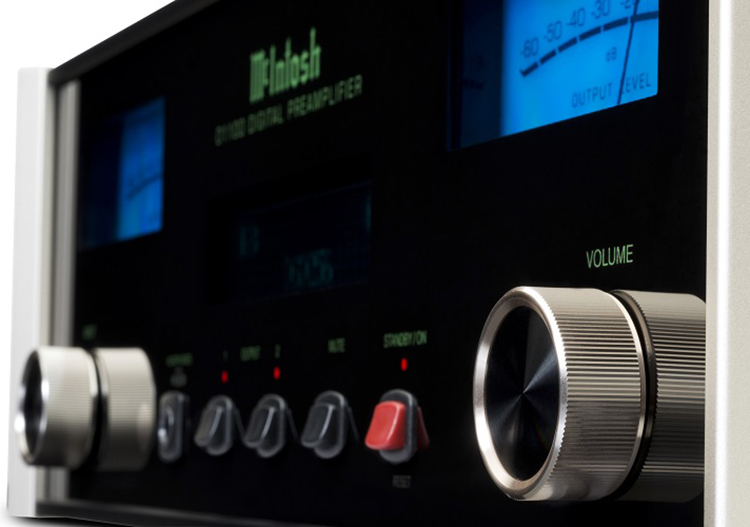
If you wish, you can rename inputs on the D1100 to be more indicative of your source component (i.e. change the USB input to “Computer” for example). You can configure the D1100 to skip unused inputs too, which is a handy feature. All changes are made from the front panel volume and source buttons with turns and pushes of the two dials. While it is a bit tedious to navigate this way, you’ll only need to do it once. As someone who runs a dual-purpose audio/theater room, the only thing I missed was some form of home theater bypass connection. This would have made it much easier to switch between the D1100 and my Marantz AV8801 A/V preamp. Considering many of McIntosh’s other preamps sport a pass-through feature, this is a surprising omission. Fortunately, my Wyred 4 Sound amp has both XLR and RCA inputs for each channel so I was able to switch between preamps by simply switching the input source on my left and right amp channels. The D1100 includes a slim, stylish remote control as well. It’s very functional, though buttons for direct input source selection are absent. You’ll have to use the source up/down buttons to scroll through all available inputs to find the one you want. This is a good reason to program the D1100 to skip any unused ones. On the whole, the D1100 was incredibly simple to setup and use. I don’t think it took me more than ten minutes to get everything connected and ready to play.
Secrets Sponsor
Since I use a Windows 10 PC as my media player/server, I’ll take a moment to explain how to get a Windows box working with the D1100. First, download the “McIntosh USB Audio Windows Driver D v1.0” from the support section of the McIntosh website. Install it using all the defaults and you should be all set. This driver install also installs the McIntosh-HD USB Audio Control Panel software, which allows you to make changes to how the D1100 receives the signal over USB (buffer depth, etc). The defaults worked perfectly in my setup. Where I did run into some issues was with my choice of media players. I initially started off using Foobar2000, but no matter what I did, I couldn’t get a pure DSD signal over to the D1100. After nearly two hours of trying different drivers, plug-ins, etc., I threw in the towel. While this was a giant failure for me as an IT professional, I figured a different approach was in order. I downloaded a copy of JRiver Media Center (v23) and within about 4 minutes had it installed and working perfectly. All I had to do was go into JRiver’s setup options and select the “McIntosh-HD” device from the drop-down menu of available playback devices. Now every PCM and DSD format showed on the D1100’s display. Of course, Mac users don’t need any special drivers and would just need to select the D1100 as the playback device via their media player.
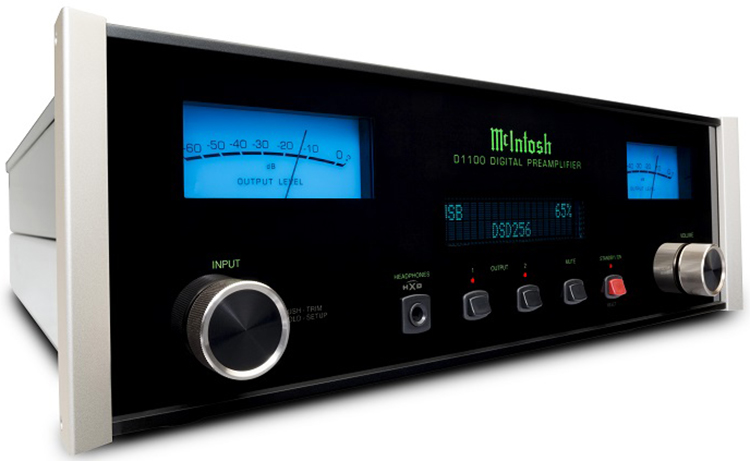
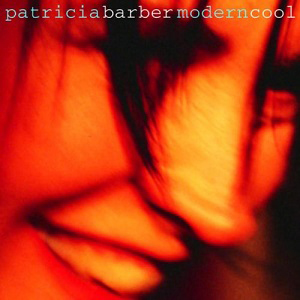
After letting the D1100 “burn-in” for about two weeks, I started off with some 44.1kHz Red Book CD playback through the OPPO UDP-205 to get a feel for the D1100. Starting with Patricia Barber’s “Modern Cool” (CD: Premonition B00002B5CI), I selected one of my favorite tracks, “Touch of Trash.”
I was completed shocked at how much better this disc sounded through the McIntosh D1100 than my current Marantz preamp. The first thing that hit me was the amazing stand-up bass. It was rich, deep, and incredibly full-sounding without seeming bloated or overripe. I did a double-take, wondering if my subs were somehow getting a signal. They weren’t. It sounded like my Olympicas magically picked up an extra 5-10Hz of low end output. Barber’s voice was crystal clear, with razor-sharp definition of each syllable and inflection. I could distinctly hear the layer of added reverb they put on her vocal track but it combined with the original vocal to give a rich, full presentation. Cymbals shimmered with incredible air and the trumpets were appropriately “brassy”, forward but not harsh. There was a smoothness to the overall presentation that belied its humble 44.1kHz/16-bit roots. I’ve used this track to demo tons of equipment and this is possibly the best I’d ever heard this song sound.

After the exceptional experience with “Modern Cool” there was no reason to continue spinning CDs so I switched the D1100 over to its USB input and started feeding in some high-resolution sources via JRiver. I started with Diana Krall’s latest, “Turn Up the Quiet” (192kHz/24-bit FLAC from HDTracks.com).
This album is a return to her jazzy roots, with the excellent recording quality typical of Krall’s work. While every track on this album sounds great, “Sway” really showed off the D1100’s merits. The acoustic guitar that starts off the song had the perfect balance of detail and richness. The subtle plucking of each string was perfectly rendered and I could feel the body of the instrument with each note. Krall is very closely mic’d on this track and you could hear the sound of her lips moving against her teeth and gums, or when her tongue wet her lips. While slightly distracting (some might say gross?), it is also an exceptional display of the detail captured during this recording. Krall’s excellent phrasing was on prominent display, though the close mic did present a slight emphasis on sibilance. Shy of that one minor issue, her vocals sounded beautiful. As with the Barber disc, bass was very strong, with the natural bass lines being incredibly clear and deep. I could actually feel the notes vibrating through the couch – nice! Imaging was also exceptional, with the vocal being centered but slightly higher on the soundstage than the instruments. The instruments themselves were presented clearly across the soundstage, which combined with the very smooth nature of the overall sound to make me feel like I was listening to a live performance in a very intimate club setting.

As I wanted to hear some quality classical music next, I pointed my web browser over to 2L’s site (www.2l.no) and downloaded some of their free samples. Many of these are available in multiple formats so you can see what you think sounds best on your system.
Marianne Thorsen with the Trondheim Solistene’s performance of Mozart’s “Violin Concerto in D major: Allegro” (2016 MQA Remix, 352.8kHz/24-bit recorded in DXD), could quite possibly be the best sounding classical piece I’ve ever heard. While I have a number of 2L recordings (mostly Blu-ray audio discs), all I can really say about this track is – Wow! The 352.8kHz DXD version has incredible dynamics and exceptional clarity. The violins have just a touch of bite when the bows initially hit the strings (as they should) but that initial edge gives way to a wonderfully delicate, sweet tone as each note continues. It was so easy to follow the fast violin notes that pervade through this recording. Through the D1100 everything just sounded so realistic and “analog.” This is a great performance and was perfectly captured. I also ran this same file through my OPPO player, with the its DAC doing the decoding and then feeding an analog XLR signal to my Marantz preamp in Pure Direct mode with no DSP or subwoofer engagement. While the file still sounded very good, it was clearly not up to the level of what I heard through the D1100. The OPPO’s DAC is no slouch, so I have to chalk the discrepancy in sound up to the preamp capabilities of the D1100. While I didn’t expect a mid-range A/V preamp to equal a high-end stereo preamp’s sound quality, I certainly didn’t expect such a tremendous difference. Through the D1100, I was sitting in the best seat in the concert hall. Through my Marantz, I was clearly listening to a recording of a live event. The richness and feeling of space were greatly diminished, bass was less impactful, and imaging and sound staging collapsed. I wish I could have tried comparing DACs directly, but since the D1100 doesn’t have a single analog input I couldn’t pass the converted signal from the UDP-205 directly to the D1100 to compare any DAC-derived differences.
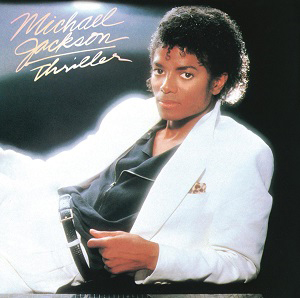
I’ve read a lot of reviews about how great the release of Michael Jackson’s “Thriller” is in DSD, so I purchased a copy from HDTracks.com (DSD64). As a child of the 80’s, I can’t tell you how many times the original vinyl version of “Thriller” was played in my home.
Playing the DSD64 version through the D1100 brought back some very fond memories, but with some nice new additions. While I let the entire album play through, “Billie Jean” is the stand-out to me. The bass that the D1100 can deliver really ratcheted up my enjoyment of this song, filling the room with sound. Michael Jackson’s voice had a clarity that I’ve never heard from any of his recordings before. I also never heard the subtle finger-snaps that accompany some of MJ’s vocals. I guess he was getting into the groove while in the recording booth. I was feeling it too, and found myself shamelessly bopping around the room. The funk guitar breakdown in the latter half of the song had the right amount of punch in the mix and had me playing air-guitar right along. I would have to break out my original vinyl (and hook up a turntable) for a refresher, but this DSD version sounded a touch brighter in the treble and midrange to my ears. However, the added detail this brought was revelatory and helped further my appreciation for how great this album is.
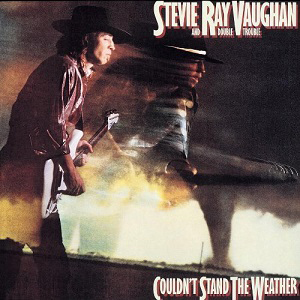
Looking to kick things up a notch, I queued up Stevie Ray Vaughn and Double Trouble’s “Couldn’t Stand the Weather” (176kHz/24-bit FLAC, HDTracks.com) and went straight to “Voodoo Chile.” I have the album on SACD and think it sounds very good, but this higher resolution version is audibly superior.
As with previous tracks, the first thing that hit me was the much more potent bass delivered by the D1100. Punchy and dynamic, yet nuanced, the bassline seemed to growl along, laying down the groove for the rest of the instruments. Drums were powerful, but sounded very tight. Vocals were spot-on, with Vaughn’s voice cutting nicely through the mix. What impressed me most though was how realistic SRV’s Strat sounded. Through the D1100, it sounded like I was sitting with my own Stratocaster right in front of my old Fender tube amp, the tone was eerily accurate.

Sticking with the blues, I switched over to an absolute gem of a recording that I discovered while searching for some good DXD files: “Carmen Gomes Sings the Blues” (DXD 352.8kHz, www.soundliaison.com).
If you go to the website, you’ll find a two-minute sample of the first cut from this album, “A Fool for You,” available for free so you can determine which format and resolution sounds best on your equipment. This album was originally recorded in DXD 352.8kHz but is available in PCM, FLAC, DSD, and DXD at multiple resolutions. While they all sounded great, there were audible differences that I could detect when feeding the files through the D1100. The PCM and FLAC files were all pretty similar, though the 352kHz FLAC file was a bit better. Things started getting interesting with the DSD files. DSD64 and DSD128 both sounded good, but stepping up to the DSD256 encoded version offered up a noticeably better sense of realism and acoustical space. The sound finally transcended the realm of digital and started sounding live. Then I tried the 352.8kHz DXD (the original recording format for this album). While not a tremendous step up from the DSD256 file, the final pieces of the sound snapped into focus. The DXD file removed the thinnest of veils from the sound and brought me right into the recording space. The overall sound was smoother, but had additional clarity and depth to it. It wasn’t a huge difference, but repeated back-to-back playing of the DSD256 versus the DXD file led me to the same conclusion. Since the music was not only impressively recorded, but also just plain excellent I purchased the full album in DXD. Listening to “Losing Hand” through the D1100 convinced me that this could be one of the best recordings I’ve ever had the joy of listening too. Gomes’ voice is both beautiful and haunting, a perfect combination for soulful blues. In possibly the best example of capturing the recording space I’ve ever heard, Gomes’ voice stayed just slightly right of center, but seemed to sit about two feet higher on the soundstage compared to the instruments. The acoustic bass was once again a standout, showing how controlled the D1100 could keep things in the low end. The guitar and drums sounded like they in the room with me. If you get a chance, check this recording out. It really is that good. I developed a new appreciation for my speakers with this album. I knew that they sounded good, but I finally got a chance to hear what they could really do.

Switching things up a bit, the next thing I queued up was the 96kHz/24-bit FLAC version of Metallica’s latest release, “Hardwired…to Self Destruct” (technically discontinued due to complaints of poor dynamic range but you can find it if you look hard enough).
While I love the music on this album I was left a little disappointed with the sound quality on the CD. Even though Hardwired was mixed infinitely better than the abysmal “Death Magnetic” I still found the overall sound slightly compressed and with a slight emphasis on the upper midrange and lower treble registers. This made the whole album a bit bright sounding to me. Happily, the 96/24 mix completely fixed those issues. Gone were the occasional harsh transients and hard-sounding guitar notes. “Halo On Fire” made it incredibly easy to pinpoint the improvements of this higher-quality mix. The sound was much more dynamic than the CD, with less obvious compression. Bass was absolutely pummeling, recreating Metallica’s trademark machine gun-staccato sound with aplomb. The guitar tracks were forward without being harsh and the bass line remained audible at all times. What really impressed me the most was the fact that I could actually distinguish the different layers of this song on the high-res FLAC version. The CD made everything sound very flat (even through the D1100 – I double-checked), but with the FLAC version there was now real depth to the mix. Playing this version through the McIntosh just made me love this album even more.
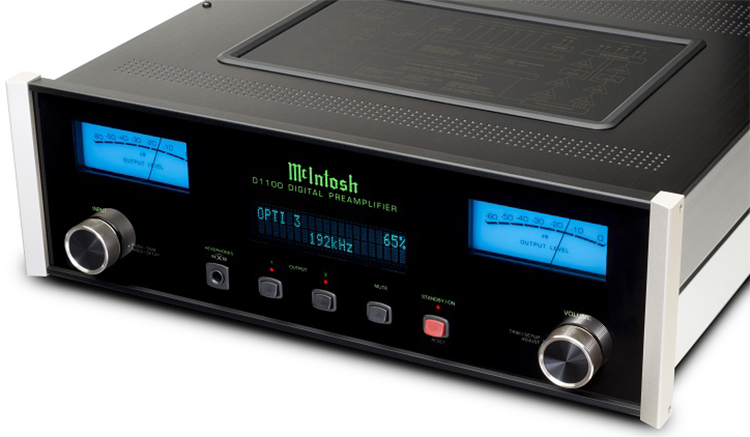
At $7000, THE MCINTOSH D1100 2-CHANNEL DIGITAL PREAMPLIFIER isn’t cheap, but it delivers stellar performance worthy of its price point and McIntosh Labs’ rich heritage.
- Rock-solid build quality
- Surprisingly easy to set up and operate
- Excellent integration of DAC and pre-amp
- Amazing bass performance
- Beautifully neutral midrange
- Highly detailed treble
- Exceptional dynamics
- Excellent imaging and soundstage depth
- Ability to decode MQA and DSD512 sources
- DSD bitstream support from non-McIntosh disc players
- Multi-channel audio support
- Home theater passthrough mode
- Built-in networking
- A second USB input
$7,000 for an audio component is certainly not cheap. However, when you weigh the total cost of a separate reference-quality preamplifier and a cutting-edge DAC (plus the cabling required to connect them), the McIntosh D1100’s price seems very fair to me. Integrating the two components makes for an ease of use that separate boxes will always struggle to match. You also get fantastic build quality, iconic styling, great ease of use, and those really cool glowing output meters. As a cherry on top, the sound quality of the McIntosh 2-Channel D1100 Digital Preamplifier is absolutely fantastic. If your system is entirely digital, the D1100 delivers stellar performance worthy of its price point and McIntosh Labs’ rich heritage.
I realize that the more I wrote about the music I listened to, the less I talked about the McIntosh D1100 2-Channel Digital Preamplifier. That is really the highest praise I can give to an audio component. Listening to quality music through the D1100 brought me a level of involvement and joy that I have not experienced in a long time. I wasn’t thinking about the playback gear, I was simply getting lost in the sound. I had forgotten just how good two-channel music can be when played through a top-notch piece of gear and the D1100 did nothing to pull me out of my sonic dreamland. From a sound quality perspective, the McIntosh D1100 delivered everything I could possibly want; amazing bass, a beautiful midrange, detailed and airy treble, stunning imaging, and an expansive soundstage. It brought out the best qualities of my speakers and made them sound better than I had ever heard them before. Most impressive though was how high-quality sources through the D1100 made me feel like I was sitting in the recording space, not listening to a recreation of an event. When fed the right media, the McIntosh D1100 didn’t sound like a digital component, it sounded like reality. It handled every digital format I threw at it without a hiccup and was a breeze to set up and operate. Yes, there are a few things that I wish could have been included (MQA support and a home theater passthrough are my top two), but the D1100’s flaws are minor sins of omission and won’t concern every potential buyer. Of greater importance are the capabilities of the D1100. With its excellent build quality, classic design, and incredible overall performance, the McIntosh D1100 2-Channel Digital Preamplifier could easily be all you need to run your purely digital music system.


